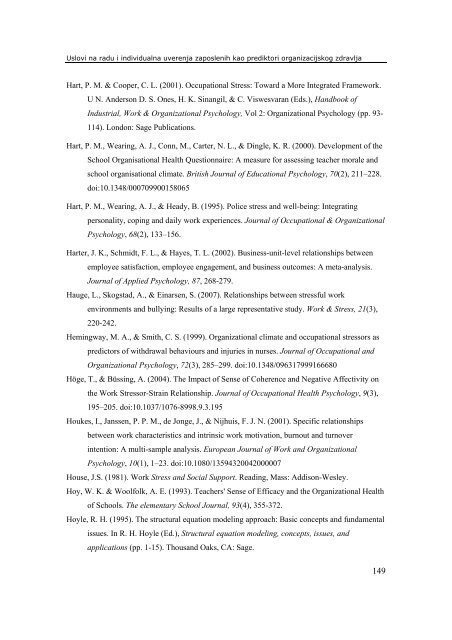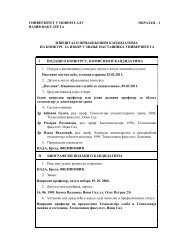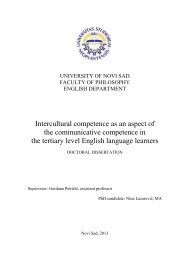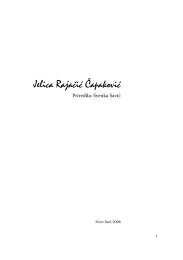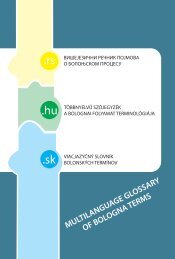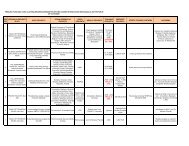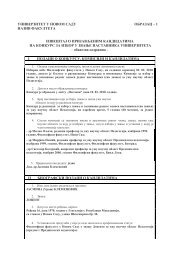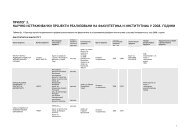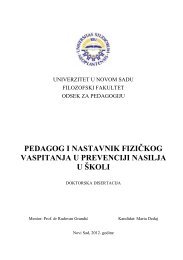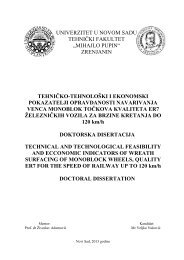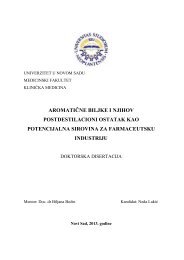Univerzitet u Novom Sadu Filozofski fakultet Odsek za psihologiju ...
Univerzitet u Novom Sadu Filozofski fakultet Odsek za psihologiju ...
Univerzitet u Novom Sadu Filozofski fakultet Odsek za psihologiju ...
Create successful ePaper yourself
Turn your PDF publications into a flip-book with our unique Google optimized e-Paper software.
Uslovi na radu i individualna uverenja <strong>za</strong>poslenih kao prediktori organi<strong>za</strong>cijskog zdravlja<br />
Hart, P. M. & Cooper, C. L. (2001). Occupational Stress: Toward a More Integrated Framework.<br />
U N. Anderson D. S. Ones, H. K. Sinangil, & C. Viswesvaran (Eds.), Handbook of<br />
Industrial, Work & Organi<strong>za</strong>tional Psychology, Vol 2: Organi<strong>za</strong>tional Psychology (pp. 93-<br />
114). London: Sage Publications.<br />
Hart, P. M., Wearing, A. J., Conn, M., Carter, N. L., & Dingle, K. R. (2000). Development of the<br />
School Organisational Health Questionnaire: A measure for assessing teacher morale and<br />
school organisational climate. British Journal of Educational Psychology, 70(2), 211–228.<br />
doi:10.1348/000709900158065<br />
Hart, P. M., Wearing, A. J., & Heady, B. (1995). Police stress and well-being: Integrating<br />
personality, coping and daily work experiences. Journal of Occupational & Organi<strong>za</strong>tional<br />
Psychology, 68(2), 133–156.<br />
Harter, J. K., Schmidt, F. L., & Hayes, T. L. (2002). Business-unit-level relationships between<br />
employee satisfaction, employee engagement, and business outcomes: A meta-analysis.<br />
Journal of Applied Psychology, 87, 268-279.<br />
Hauge, L., Skogstad, A., & Einarsen, S. (2007). Relationships between stressful work<br />
environments and bullying: Results of a large representative study. Work & Stress, 21(3),<br />
220-242.<br />
Hemingway, M. A., & Smith, C. S. (1999). Organi<strong>za</strong>tional climate and occupational stressors as<br />
predictors of withdrawal behaviours and injuries in nurses. Journal of Occupational and<br />
Organi<strong>za</strong>tional Psychology, 72(3), 285–299. doi:10.1348/096317999166680<br />
Höge, T., & Büssing, A. (2004). The Impact of Sense of Coherence and Negative Affectivity on<br />
the Work Stressor-Strain Relationship. Journal of Occupational Health Psychology, 9(3),<br />
195–205. doi:10.1037/1076-8998.9.3.195<br />
Houkes, I., Janssen, P. P. M., de Jonge, J., & Nijhuis, F. J. N. (2001). Specific relationships<br />
between work characteristics and intrinsic work motivation, burnout and turnover<br />
intention: A multi-sample analysis. European Journal of Work and Organi<strong>za</strong>tional<br />
Psychology, 10(1), 1–23. doi:10.1080/13594320042000007<br />
House, J.S. (1981). Work Stress and Social Support. Reading, Mass: Addison-Wesley.<br />
Hoy, W. K. & Woolfolk, A. E. (1993). Teachers' Sense of Efficacy and the Organi<strong>za</strong>tional Health<br />
of Schools. The elementary School Journal, 93(4), 355-372.<br />
Hoyle, R. H. (1995). The structural equation modeling approach: Basic concepts and fundamental<br />
issues. In R. H. Hoyle (Ed.), Structural equation modeling, concepts, issues, and<br />
applications (pp. 1-15). Thousand Oaks, CA: Sage.<br />
149


